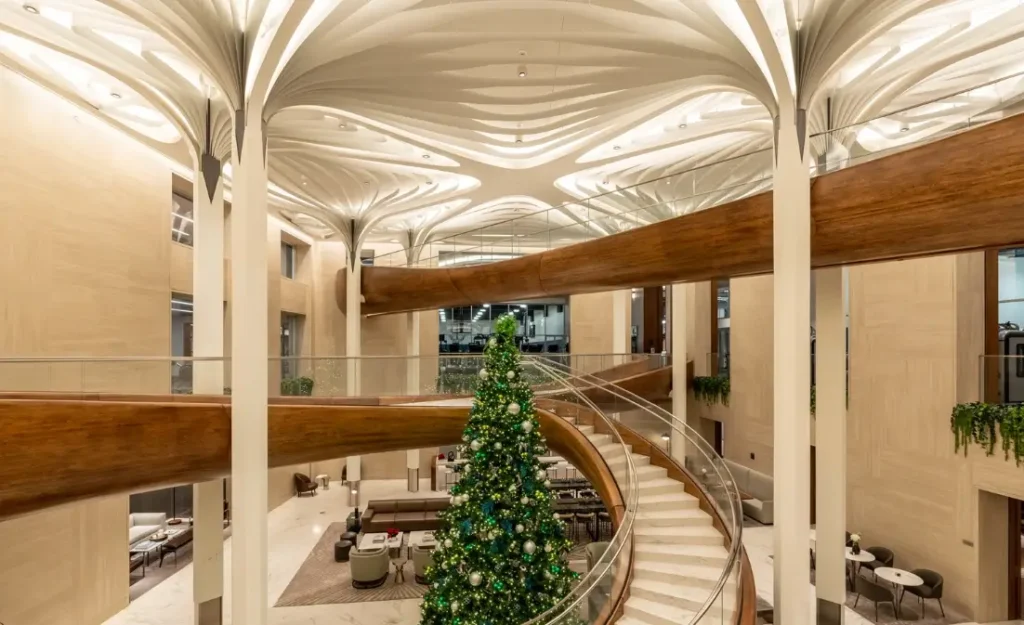The modern design world is a playground for complex forms and innovative structures, and the secret sauce behind much of this innovation is parametric design software. These tools allow architects, engineers, and designers to create intricate, flexible models that can adapt to any number of variables, leading to creative breakthroughs and refined solutions across various industries. Let’s dive into five of the most powerful parametric design software options available today—Grasshopper 3D, Fusion 360, Solidworks, CATIA, GenerativeComponents, and Dynamo—and explore how each one contributes to mastering complex geometries in its own unique way.
Grasshopper 3D: The Architect’s Playground
When we talk about parametric design, it’s almost impossible not to mention Grasshopper 3D. Widely regarded as the go-to tool for architects, Grasshopper 3D is a visual programming interface integrated with Rhinoceros 3D (Rhino), another favorite among designers. The beauty of Grasshopper lies in its ability to seamlessly combine algorithmic logic with architectural creativity, giving users the flexibility to script, design, and manipulate forms through visual nodes without having to write traditional code.
Features and Strengths
One of Grasshopper’s most praised features is its drag-and-drop interface. Unlike traditional coding, where syntax errors can often trip you up, Grasshopper allows you to visually connect components that represent different operations or mathematical functions. This method makes creating complex geometries feel more intuitive and accessible, even for those without a background in programming.
For example, the famous V&A Dundee museum in Scotland, designed by Kengo Kuma, relied heavily on Grasshopper to create its complex, curved façade. The design demanded precise control over form and materiality, which Grasshopper provided through algorithmic generation, allowing the team to adjust and optimize the building’s geometry in response to real-time data.

Another standout feature is Grasshopper’s plug-in ecosystem, which includes tools like Kangaroo for real-time physics simulations, Ladybug for environmental analysis, and Karamba3D for structural analysis. These extensions make Grasshopper incredibly versatile, transforming it into a powerhouse for everything from sustainable design to structural engineering.
Applications
Grasshopper is a favored tool for designing organic and freeform structures. In architecture, it excels at creating parametric facades, shell structures, and even urban planning models that react to changes in environmental data. The software’s flexibility in handling non-linear geometries and complex constraints makes it perfect for early-stage design exploration. It’s also finding its place in fashion design, industrial design, and even automotive prototyping, where organic forms and optimized structures are increasingly in demand.
But the true magic of parametric design within Grasshopper is how it enables the user to rapidly iterate. A single tweak to a parameter can ripple through an entire design, updating every connected element. This is particularly powerful in architecture, where building designs need to adapt to site conditions, regulations, and performance criteria on the fly.
Fusion 360: The Cross-Industry Collaborator
Fusion 360, developed by Autodesk, is another parametric design tool that has taken the industry by storm. Known for its cloud-based architecture, Fusion 360 allows users to work collaboratively across different locations and disciplines, making it a favorite in industries where teamwork and iteration are key.
Features and Strengths
One of Fusion 360’s standout features is its real-time collaboration capabilities. Because the software is cloud-based, team members can access and edit models simultaneously from anywhere in the world. This is a game-changer for industries like automotive and consumer product design, where teams are often spread across different geographic locations.
Another key feature is Fusion 360’s ability to integrate generative design workflows, allowing users to define goals and constraints and let the software explore thousands of design options. This feature leverages the power of parametric design by helping users generate geometries that are optimized for weight, strength, and material usage. For instance, the aerospace industry has used Fusion 360’s generative design tools to create lightweight, yet strong, components for aircraft, reducing fuel consumption and overall costs.
Fusion 360’s strength also lies in its all-in-one approach. It combines CAD, CAM, and CAE functionalities into a single platform, streamlining the entire workflow from concept to fabrication. Its parametric modeling capabilities allow designers to build adaptive models, making it easy to tweak dimensions, materials, and constraints without having to redo the entire model.
Applications
While Grasshopper is more niche towards architecture and organic forms, Fusion 360 shines in mechanical engineering, product design, and aerospace. Its powerful simulation and generative design tools make it ideal for optimizing the performance of mechanical components and reducing material waste. Companies like General Motors and Airbus have leveraged Fusion 360 to create lightweight, efficient parts that meet stringent industry regulations.
For example, General Motors used Fusion 360’s generative design capabilities to reimagine seat brackets, reducing the weight of each part by over 40%. This not only improved fuel efficiency but also cut production costs—a perfect example of how parametric design can yield tangible, real-world benefits.
Solidworks: The Engineer’s Best Friend
In the world of parametric design, Solidworks has long been a trusted name, particularly among mechanical engineers and industrial designers. Known for its robust feature set and ease of use, Solidworks excels at creating detailed, fully parametric models of mechanical components.
Features and Strengths
Solidworks is lauded for its parametric modeling capabilities, which allow users to build models that can be easily adjusted by changing key parameters. Whether it’s altering the diameter of a hole or the length of a shaft, Solidworks ensures that the entire model updates seamlessly based on the designer’s input.
One of Solidworks’ key advantages is its advanced simulation tools. Users can test how their designs will perform under real-world conditions, such as stress, heat, or vibration. This feature is particularly useful for industries like automotive and aerospace, where safety and reliability are paramount. For instance, SpaceX has used Solidworks to design and test components for its Falcon rockets, ensuring they can withstand the intense forces of space travel.
Solidworks also integrates well with manufacturing processes, providing tools for sheet metal design, weldments, and mold design. Its 3D rendering capabilities allow for photorealistic visualization, helping designers and engineers better communicate their ideas to stakeholders before the product ever hits the production floor.
Applications
While Solidworks is known for its role in mechanical design, its parametric capabilities extend into areas like consumer product design, robotics, and even medical device development. Its strength lies in its ability to handle highly detailed parts and assemblies, making it a go-to tool for anyone working on complex geometries in engineered products.
CATIA: The Giant of Aerospace and Automotive
When we talk about parametric design in high-stakes industries like aerospace and automotive, CATIA is the software of choice. Developed by Dassault Systèmes, CATIA (Computer-Aided Three-Dimensional Interactive Application) is renowned for its ability to handle extremely complex geometries and large assemblies, making it indispensable in industries where precision and performance are critical.
Features and Strengths
One of CATIA’s standout features is its ability to manage extremely large datasets and complex models without sacrificing performance. This makes it ideal for designing the intricate systems found in aircraft and automobiles, where every component must fit perfectly with the rest of the assembly. For example, Boeing used CATIA to design its 787 Dreamliner, a massive project that required the integration of thousands of individual parts.
CATIA’s parametric design capabilities are incredibly robust. It allows users to create associative models, where changes to one part of the design automatically update the rest of the assembly. This level of precision is crucial in industries where even a small error can result in costly setbacks. Additionally, CATIA integrates PLM (Product Lifecycle Management), allowing companies to manage the entire lifecycle of a product, from concept to retirement.
CATIA also supports advanced surface modeling, enabling designers to create highly detailed and smooth surfaces, which is essential in the automotive industry for creating aerodynamically optimized shapes. This is one reason why companies like Tesla and BMW use CATIA for vehicle design and development.
Applications
CATIA’s parametric modeling capabilities are ideal for industries that demand extreme precision and complexity. It’s widely used in aerospace, automotive, and shipbuilding, where every component must be designed to exact specifications. Its ability to handle complex geometries and massive assemblies sets it apart from other parametric tools, making it the go-to choice for large-scale engineering projects.
GenerativeComponents: Parametric Design for Civil Engineering
GenerativeComponents, developed by Bentley Systems, is a parametric design software that’s tailored to infrastructure and civil engineering projects. Unlike some of the other tools on this list, GenerativeComponents is specifically geared toward designing complex geometries for large-scale infrastructure projects like bridges, tunnels, and skyscrapers.
Features and Strengths
GenerativeComponents excels in creating algorithmically driven designs that adapt to real-world constraints. For example, when designing a bridge, the software can take into account factors like load-bearing capacity, environmental conditions, and material properties to generate optimized forms that meet all necessary criteria. This makes it a favorite among civil engineers who need to design complex structures that are both efficient and aesthetically pleasing.
One of the key features of GenerativeComponents is its ability to handle parametric relationships between different elements of a design. For example, if the height of a bridge’s support pillars changes, the software will automatically update the rest of the structure to ensure everything stays in proportion. This kind of parametric design ensures that complex geometries remain consistent and accurate throughout the design process.
Applications
GenerativeComponents is primarily used in civil engineering and infrastructure design. Its parametric capabilities make it ideal for creating complex geometries in projects like stadiums, bridges, and skyscrapers, where precision and efficiency are paramount. The software has been used in projects like the Burj Khalifa, where the complex, spiraling form of the building required sophisticated parametric modeling to achieve.
Dynamo: BIM Meets Parametric Design
For those working in Building Information Modeling (BIM) environments, Dynamo is an essential parametric tool. Developed by Autodesk, Dynamo is a visual programming tool that integrates with Revit, allowing architects and engineers to create complex geometries and automate repetitive tasks within a BIM framework.
Features and Strengths
One of Dynamo’s key strengths is its ability to automate workflows. For example, if you need to generate thousands of windows on a façade with varying sizes and positions, Dynamo can automate the entire process based on predefined parameters. This saves an enormous amount of time and reduces the risk of human error.
Dynamo also excels at creating custom parametric families within Revit. Whether it’s a custom roof truss system or a unique façade pattern, Dynamo allows you to create and manipulate these forms with precision. It’s also great for automating tasks like data extraction, performance analysis, and even cost estimation, making it a valuable tool for project managers and engineers alike.
Applications
Dynamo is primarily used in architecture and engineering for creating custom parametric designs within a BIM environment. It’s particularly useful for designing facades, interior layouts, and structural systems that need to adapt to changing parameters. For example, Zaha Hadid Architects used Dynamo to create the intricate façade of the Morpheus Hotel in Macau, where the complex geometry of the exoskeleton required real-time adjustments to the design.

Conclusion: Finding the Right Tool for the Job
Each of these parametric design tools offers unique advantages depending on the industry and project requirements. Whether you’re an architect exploring organic forms with Grasshopper, an engineer optimizing mechanical components in Solidworks, or a civil engineer tackling large-scale infrastructure with GenerativeComponents, there’s a parametric design tool tailored to your needs.
The rise of parametric design has revolutionized the way we approach complex geometries, allowing designers to move beyond traditional constraints and explore new frontiers in creativity and functionality. By leveraging these tools, you can not only push the boundaries of design but also ensure that your projects are optimized for performance, sustainability, and cost-effectiveness.




Pingback: AI Driven Space Optimization Software -